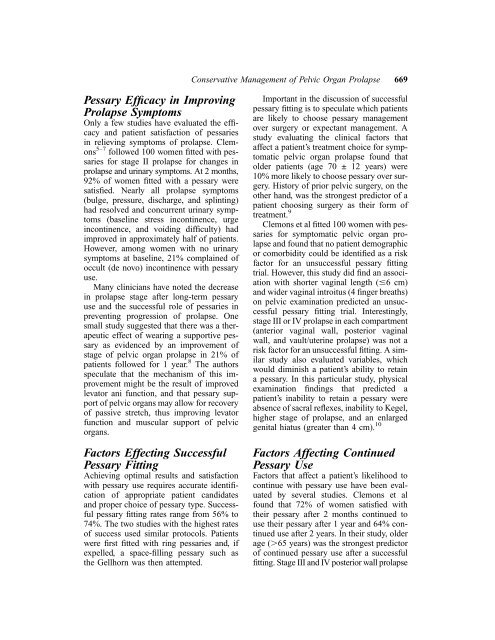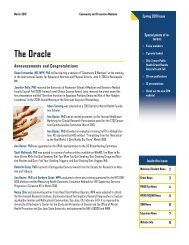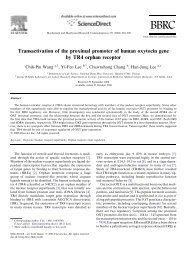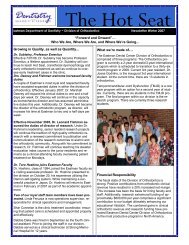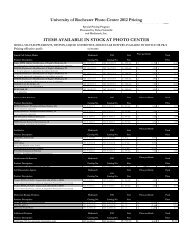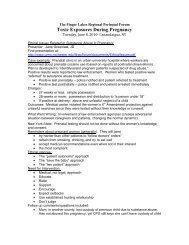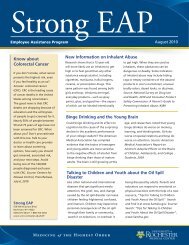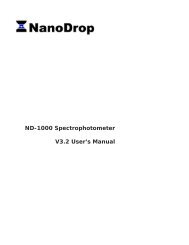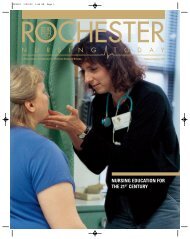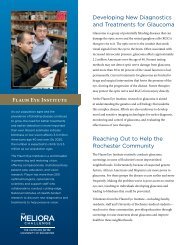Conservative Management of Pelvic Organ Prolapse
Conservative Management of Pelvic Organ Prolapse
Conservative Management of Pelvic Organ Prolapse
You also want an ePaper? Increase the reach of your titles
YUMPU automatically turns print PDFs into web optimized ePapers that Google loves.
Pessary Efficacy in Improving<br />
<strong>Prolapse</strong> Symptoms<br />
Only a few studies have evaluated the efficacy<br />
and patient satisfaction <strong>of</strong> pessaries<br />
in relieving symptoms <strong>of</strong> prolapse. Clemons<br />
5–7 followed 100 women fitted with pessaries<br />
for stage II prolapse for changes in<br />
prolapse and urinary symptoms. At 2 months,<br />
92% <strong>of</strong> women fitted with a pessary were<br />
satisfied. Nearly all prolapse symptoms<br />
(bulge, pressure, discharge, and splinting)<br />
had resolved and concurrent urinary symptoms<br />
(baseline stress incontinence, urge<br />
incontinence, and voiding difficulty) had<br />
improved in approximately half <strong>of</strong> patients.<br />
However, among women with no urinary<br />
symptoms at baseline, 21% complained <strong>of</strong><br />
occult (de novo) incontinence with pessary<br />
use.<br />
Many clinicians have noted the decrease<br />
in prolapse stage after long-term pessary<br />
use and the successful role <strong>of</strong> pessaries in<br />
preventing progression <strong>of</strong> prolapse. One<br />
small study suggested that there was a therapeutic<br />
effect <strong>of</strong> wearing a supportive pessary<br />
as evidenced by an improvement <strong>of</strong><br />
stage <strong>of</strong> pelvic organ prolapse in 21% <strong>of</strong><br />
patients followed for 1 year. 8 The authors<br />
speculate that the mechanism <strong>of</strong> this improvement<br />
might be the result <strong>of</strong> improved<br />
levator ani function, and that pessary support<br />
<strong>of</strong> pelvic organs may allow for recovery<br />
<strong>of</strong> passive stretch, thus improving levator<br />
function and muscular support <strong>of</strong> pelvic<br />
organs.<br />
Factors Effecting Successful<br />
Pessary Fitting<br />
Achieving optimal results and satisfaction<br />
with pessary use requires accurate identification<br />
<strong>of</strong> appropriate patient candidates<br />
and proper choice <strong>of</strong> pessary type. Successful<br />
pessary fitting rates range from 56% to<br />
74%. The two studies with the highest rates<br />
<strong>of</strong> success used similar protocols. Patients<br />
were first fitted with ring pessaries and, if<br />
expelled, a space-filling pessary such as<br />
the Gellhorn was then attempted.<br />
<strong>Conservative</strong> <strong>Management</strong> <strong>of</strong> <strong>Pelvic</strong> <strong>Organ</strong> <strong>Prolapse</strong> 669<br />
Important in the discussion <strong>of</strong> successful<br />
pessary fitting is to speculate which patients<br />
are likely to choose pessary management<br />
over surgery or expectant management. A<br />
study evaluating the clinical factors that<br />
affect a patient’s treatment choice for symptomatic<br />
pelvic organ prolapse found that<br />
older patients (age 70 ± 12 years) were<br />
10% more likely to choose pessary over surgery.<br />
History <strong>of</strong> prior pelvic surgery, on the<br />
other hand, was the strongest predictor <strong>of</strong> a<br />
patient choosing surgery as their form <strong>of</strong><br />
treatment. 9<br />
Clemons et al fitted 100 women with pessaries<br />
for symptomatic pelvic organ prolapse<br />
and found that no patient demographic<br />
or comorbidity could be identified as a risk<br />
factor for an unsuccessful pessary fitting<br />
trial. However, this study did find an association<br />
with shorter vaginal length (#6 cm)<br />
and wider vaginal introitus (4 finger breaths)<br />
on pelvic examination predicted an unsuccessful<br />
pessary fitting trial. Interestingly,<br />
stage III or IV prolapse in each compartment<br />
(anterior vaginal wall, posterior vaginal<br />
wall, and vault/uterine prolapse) was not a<br />
risk factor for an unsuccessful fitting. A similar<br />
study also evaluated variables, which<br />
would diminish a patient’s ability to retain<br />
a pessary. In this particular study, physical<br />
examination findings that predicted a<br />
patient’s inability to retain a pessary were<br />
absence <strong>of</strong> sacral reflexes, inability to Kegel,<br />
higher stage <strong>of</strong> prolapse, and an enlarged<br />
genital hiatus (greater than 4 cm). 10<br />
Factors Affecting Continued<br />
Pessary Use<br />
Factors that affect a patient’s likelihood to<br />
continue with pessary use have been evaluated<br />
by several studies. Clemons et al<br />
found that 72% <strong>of</strong> women satisfied with<br />
their pessary after 2 months continued to<br />
use their pessary after 1 year and 64% continued<br />
use after 2 years. In their study, older<br />
age (.65 years) was the strongest predictor<br />
<strong>of</strong> continued pessary use after a successful<br />
fitting. Stage III and IV posterior wall prolapse


